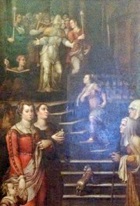

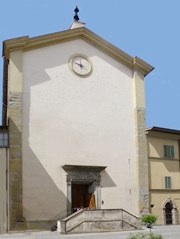
The Servites moved here from their original site outside Porta Sant’ Andrea in 1306. The original church o the site was effectively rebuilt in 1363 and consecrated in 1381.
When Angela de’ Rossi, the widow of Alessandro Vitelli, died at the nearby Palazzo Vitelli a Porta San Giacomo in 1573, she was buried in Santa Maria delle Grazie.
The church was restructured following earthquakes in 1703 and 1789.
The Servites were expelled in 1861. The church was subsequently looked after by the Compagnia della Madonna delle Grazie (which had been formed in 1514). They organised the rebuilding of the apse.
The Servites returned in 1951-62, after which the church became a parish church. It reopened in December 2013, following the repair of damage it had suffered in an earthquake earlier that year.
Exterior
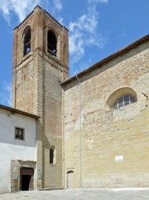
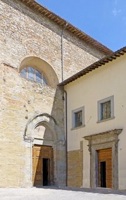
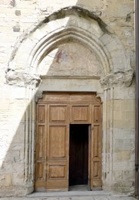
The campanile is at the end of the left wall, in Piazza dei Servi. The Gothic portal in left wall survives to the right of it, although the fresco in its lunette is barely legible. The Oratorio di Santa Maria delle Grazie (below) was built to the right in 1489.
Interior
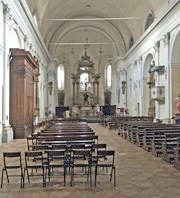
Relics from the Pieve di Saddi
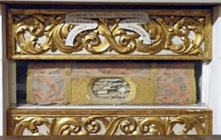
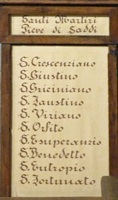
Monsignor Pompilio Mandrelli, who was the archpriest of Pietralunga in 1933-63, translated a reliquary from the Pieve di San Crescentino de’ Saddi to Santa Maria delle Grazie. A list by the reliquary (in the 3rd bay on the left) claims that it contains relics of St Crescentian and of all the other martyrs of Saddi:
-
✴St Justin;
-
✴St Grivicianus;
-
✴St Faustinus;
-
✴St Virianus;
-
✴St Orphitus;
-
✴St Esuperantius;
-
✴St Benedict;
-
✴St Eutropius; and
-
✴St Fortunatus.
Assumption of the Virgin (ca. 1436)
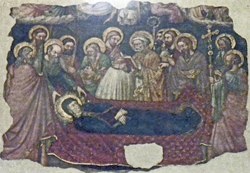
This fresco in the chapel off the right wall is attributed to Ottaviano Nelli. It was discovered under plaster on the right wall of the church in 1630 and moved here soon after.
Trinity (1639)
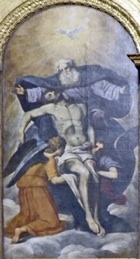
Cure of St Peregrine Laziosi (17th century)
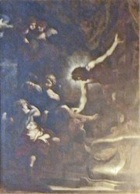
Altarpiece (ca. 1700)
This altarpiece of the Virgin with the seven founders of the Servite Order, which is now in the sacristy, is attributed to Giovanni Ventura Borghesi.
Oratorio di Santa Maria delle Grazie (1489)
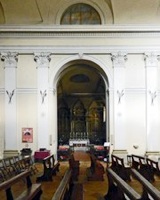
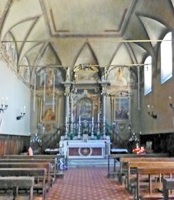
As explained above, this chapel was built on the left to house the highly venerated image of Santa Maria dell Grazie:
-
✴its original entrance (illustrated above) survives in Piazza dei Servi; and
-
✴an communicating arch (illustrated here) was opened in the left wall of the church in 1695, to a design by Giovanni Ventura Borghesi.
Madonna and Child with Saints and Angels (1456)
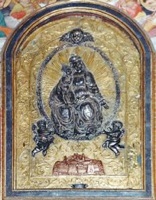
Venerated image Cover
This highly venerated image is in a tabernacle on the altar of the oratory. It is covered by a decorated shutter, but exposed each year during the celebration of the feast of Santa Maria delle Grazie (26th August) and that of the Purification of the Virgin (2nd February). The precious image was profaned by French soldiers in 1798, during the city’s “liberation”. This was one of the sparks that led to a subsequent riot, after which the city was sacked.
The image depicts the Madonna and Child with SS Floridus and Philip Benizi and two angels, one of whom (on the right) holds a model of Città di Castello. As set out above, it was commissioned for an aedicule in the street to the left of the church. The painted inscription translates: “Oh you who pass, pay honour to the Virgin Mary: 1456: Giovanni di Piamonte. It is [the only known work of this artist], whose style is close to that of Piero della Francesca. [Is the panel of St Michael and Tobias in San Giovanni Valdarno signed or simply attributed to him?] The inscription along the base of the tabernacle says that it was commissioned by the Commune at the time of the prior, Leonardo da Siena.
Scenes from the Life of the Virgin (1641-3)
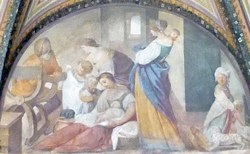
The frescoes in the lunettes high up on the walls of the oratory, which are attributed to Bernardino Gagliardi, were damaged in the earthquake of 1789 and only partially restored. The one illustrated here depicts the Birth of the Virgin.
Art from the Church
Madonna and Child with Saints (1493)
Payments were made in 1493 to Luca Signorelli for this altarpiece for the high altar. It was in the sacristy in ca. 1726, when it was said to depict the Madonna and Child with SS Floridus, Peter, Paul and Amantius. Unfortunately, it no longer survives.
Choir Stalls and Cabinet (1501)
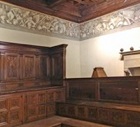
-
✴a central section with five doors and 13 inlaid panels (eleven back panels and two side panels) above; and
-
✴two side benches.
The inscription in the second panel from the right records that Antonio Bencivenni da Mercatello executed the work in 1501 for the prior, Brother Severus of Cesena.
The middle panel is now missing: given that the panels to the sides of it depict instruments of the Passion, it probably contained a scene of the Crucifixion or the Pietà. four coats of arms are depicted, belonging to: Bishop Giulio Vitelli; the Brozzi and Bufalini families; and the Servite Order.
Works Attributed to Raffaellino del Colle
Three works attributed to Raffaellino del Colle were transferred from the church to the Pinacoteca Comunale in 1912.
Annunciation (ca. 1528)
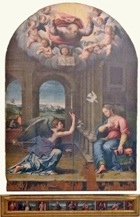
Three predella panels in the Pinacoteca Comunale, each of which depicts three saints, probably belonged to this altarpiece.
Deposition (ca. 1552)
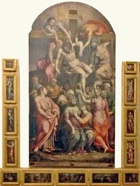
Agostino Tofanelli, the Director of the Musei Capitolini, Rome attempted to confiscate the altarpiece 1813, but (as Cristina Galassi - referenced below -has shown) the local authorities were able to resist because it was still in use in the church. (The relevant research by Christina Galassi is referenced in the page on the artist).
A number of small panels in the Pinacoteca (six depicting angels holding the instruments of the Passion and five depicting scenes from the Passion) were recently recognised as having come from this altarpiece, and are now exhibited beside it.
Presentation of the Virgin (ca. 1560)
